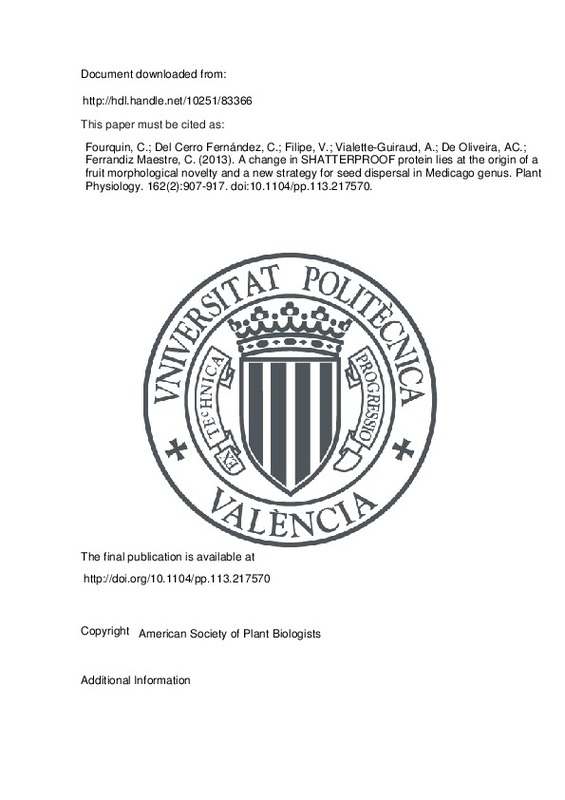JavaScript is disabled for your browser. Some features of this site may not work without it.
Buscar en RiuNet
Listar
Mi cuenta
Estadísticas
Ayuda RiuNet
Admin. UPV
A change in SHATTERPROOF protein lies at the origin of a fruit morphological novelty and a new strategy for seed dispersal in Medicago genus
Mostrar el registro sencillo del ítem
Ficheros en el ítem
| dc.contributor.author | Fourquin, Chloe
|
es_ES |
| dc.contributor.author | Del Cerro Fernández, Carolina
|
es_ES |
| dc.contributor.author | Victoria, Filipe C.
|
es_ES |
| dc.contributor.author | Vialette-Guiraud, Aurélie
|
es_ES |
| dc.contributor.author | de Oliveira, Antonio C.
|
es_ES |
| dc.contributor.author | Ferrandiz Maestre, Cristina
|
es_ES |
| dc.date.accessioned | 2017-06-21T12:15:22Z | |
| dc.date.available | 2017-06-21T12:15:22Z | |
| dc.date.issued | 2013-06 | |
| dc.identifier.issn | 0032-0889 | |
| dc.identifier.ismn | 23640757 | |
| dc.identifier.uri | http://hdl.handle.net/10251/83366 | |
| dc.description.abstract | [EN] Angiosperms are the most diverse and numerous group of plants, and it is generally accepted that this evolutionary success owes in part to the diversity found in fruits, key for protecting the developing seeds and ensuring seed dispersal. Although studies on the molecular basis of morphological innovations are few, they all illustrate the central role played by transcription factors acting as developmental regulators. Here, we show that a small change in the protein sequence of a MADS-box transcription factor correlates with the origin of a highly modified fruit morphology and the change in seed dispersal strategies that occurred in Medicago, a genus belonging to the large legume family. This protein sequence modification alters the functional properties of the protein, affecting the affinities for other protein partners involved in high-order complexes. Our work illustrates that variation in coding regions can generate evolutionary novelties not based on gene duplication/subfunctionalization but by interactions in complex networks, contributing also to the current debate on the relative importance of changes in regulatory or coding regions of master regulators in generating morphological novelties. | es_ES |
| dc.description.sponsorship | This work was supported by the Spanish Ministerio de Ciencia e Innovacion (grant no. BIO2009-09920 to C.Fe.), the European Union (grant no. FP7-PEOPLE-PIRSES-2009-247589 to C.Fe. and A.C.d.O.), and a Fellowship for Foreign Young Postdocs from the Spanish Ministerio de Ciencia e Innovacion (to C.Fo.). | en_EN |
| dc.language | Inglés | es_ES |
| dc.publisher | American Society of Plant Biologists | es_ES |
| dc.relation.ispartof | Plant Physiology | es_ES |
| dc.rights | Reserva de todos los derechos | es_ES |
| dc.subject | Carpel development | es_ES |
| dc.subject | EVO-DEVO | es_ES |
| dc.subject | Arabidopsis | es_ES |
| dc.subject | Evolution | es_ES |
| dc.subject | Genes | es_ES |
| dc.subject | Identity | es_ES |
| dc.subject | Indehiscent | es_ES |
| dc.subject | Perspective | es_ES |
| dc.subject | Leguminosae | es_ES |
| dc.subject | Truncatula | es_ES |
| dc.title | A change in SHATTERPROOF protein lies at the origin of a fruit morphological novelty and a new strategy for seed dispersal in Medicago genus | es_ES |
| dc.type | Artículo | es_ES |
| dc.identifier.doi | 10.1104/pp.113.217570 | |
| dc.relation.projectID | info:eu-repo/grantAgreement/MICINN//BIO2009-09920/ES/Conservacion De Los Modelos Geneticos Que Explican La Morfogenesis Del Carpelo Y El Fruto En Las Eudicotiledoneas/ | es_ES |
| dc.relation.projectID | info:eu-repo/grantAgreement/EC/FP7/247589/EU/ | es_ES |
| dc.rights.accessRights | Abierto | es_ES |
| dc.contributor.affiliation | Universitat Politècnica de València. Instituto Universitario Mixto de Biología Molecular y Celular de Plantas - Institut Universitari Mixt de Biologia Molecular i Cel·lular de Plantes | es_ES |
| dc.description.bibliographicCitation | Fourquin, C.; Del Cerro Fernández, C.; Victoria, FC.; Vialette-Guiraud, A.; De Oliveira, AC.; Ferrandiz Maestre, C. (2013). A change in SHATTERPROOF protein lies at the origin of a fruit morphological novelty and a new strategy for seed dispersal in Medicago genus. Plant Physiology. 162(2):907-917. https://doi.org/10.1104/pp.113.217570 | es_ES |
| dc.description.accrualMethod | S | es_ES |
| dc.relation.publisherversion | http://doi.org/10.1104/pp.113.217570 | es_ES |
| dc.description.upvformatpinicio | 907 | es_ES |
| dc.description.upvformatpfin | 917 | es_ES |
| dc.type.version | info:eu-repo/semantics/publishedVersion | es_ES |
| dc.description.volume | 162 | es_ES |
| dc.description.issue | 2 | es_ES |
| dc.relation.senia | 257542 | es_ES |
| dc.contributor.funder | European Commission | |
| dc.contributor.funder | Ministerio de Ciencia e Innovación |







![[Cerrado]](/themes/UPV/images/candado.png)

